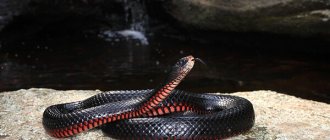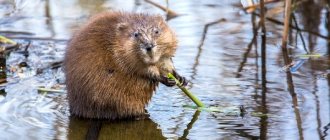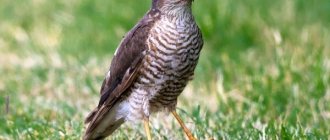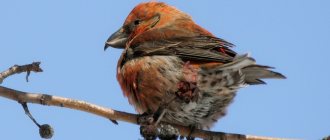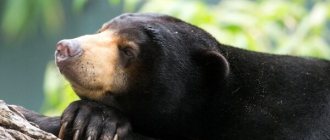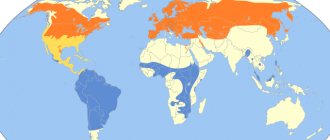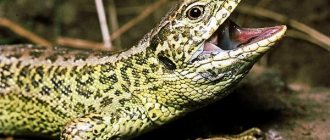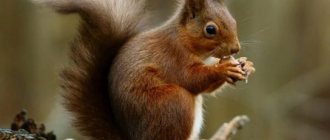Frogs live in almost all corners of our planet - amphibious creatures with bulging eyes and no tail. Today, scientists know about the existence of about 2,500 species of frogs, which differ from each other in size, lifestyle and skin color. In nature, there are quite a lot of frogs that are yellow, red and even blue, but most of them are colored green. But what exactly determines the color of these creatures? Scientists have been searching for an answer to this question for many years and, in general, it has already been found. However, in the course of each scientific work they become aware of even more interesting facts. So, these croaking creatures only seem unremarkable - in fact, many complex processes occur inside their organisms.
The transparent frog of the species Hyalinobatrachium yaku was discovered relatively recently, in 2022
Description of the African red toad
The amphibian is quite large in size: the body of an adult male is 8.6-8.8 centimeters, females are slightly larger - approximately 9.2 cm in length. The toad's body is painted in bright shades of red and brownish tones. The back is reddish-red, sometimes covered with dark brown spots in the shoulder area and lower part. The belly is usually light brown, with a slight pinkish tint, strewn with gray spots. The sides contrast with the main color: they can be very light or, on the contrary, much darker than the general background of the back and belly.
The surface of the red toad's body is covered with a much smaller number of warts when compared with representatives of toads of the same size, but of different species.
A bony outgrowth (dorsolateral ridge) specific to some toads, located on the skull, starts from the tympanic membrane typical of toads in the middle ear area and descends to the hind legs. Its upper part is much darker in color than the lower part.
The eardrum has a standard round shape and is quite large in size. The typical glands near the ears, called parotids, are invisible in this species.
On the limbs of the toad, leathery, slightly wrinkled folds located in the tarsal area stand out. On the paws of males there are characteristic growths - nuptial calluses, located on the first three toes. This structure of the limbs gives the male the ability to hold the female during the mating process.
Males have a special skin formation that distinguishes all male tailless toads - a throat pouch. It participates in the process of sound formation, acting as a resonator. The organ is actively used by males during the mating season. In a calm state, the throat pouch is folded, between the mucous membrane and skin folds surrounding the muscles.
- Scolopendra
- 32 facts about tigers
- Weasel
- Whale shark
- 34 facts about raccoons
- Maned wolf
Interesting facts about the animal
Unka differs from its relatives in interesting features:
- The pattern on the abdomen of each frog is unique. It is impossible to find two fire toads with the same arrangement and size of patterns and spots.
- Fire toads have a special anatomical structure of the tongue - its entire lower part is attached to the oral cavity. Therefore, unlike many other species of frogs, the fire-bellied toad cannot capture food with its tongue.
- Thanks to this structure of the tongue, fire-bellied toads cannot croak like their relatives. Instead, they make a sound that most closely resembles a drawn-out “oooh” sound. Because of this feature, the voices of these amphibians are also called unki or ukami.
- These small frogs move poorly on the ground; the length of their feet is almost equal to the length of their lower leg.
- Another interesting feature of the Unca is the absence of membranes on its front paws. This “gadget” is only found on the amphibian’s hind legs.
- The frog's pupils are unusual: their shape is not round or oval, but triangular.
- The toad has no eardrums or parotids (parotid venom glands). Therefore, this amphibian hears only low-frequency sounds. To do this, the toad has to press its ear to the ground.
The red-bellied firebird is a miniature frog with original eyes and a ringing voice. The number of these beautiful amphibians is steadily decreasing from year to year.
To avoid their complete destruction, man should reconsider his attitude towards nature and create comfortable living conditions for the Unk.
Habitat
The African red toad is native to the southern half of Africa, ranging from Tanzania and southern Kenya through southeastern Democratic Republic of Congo and eastern Angola south to South Africa.
Its natural habitats are dry savanna, wet savanna, subtropical or tropical dry shrubland, subtropical or tropical wet shrubland, subtropical or tropical lowland dry field, freshwater swamps, unstable freshwater swamps, arable land, grassland, urban areas, water storage areas, ponds, canals and ditches and artificial karsts.
Dart frogs are especially poisonous frogs.
But not only toads have poisonous skin glands. The most dangerous frogs for humans are frogs of the poison dart frog family (Dendrobatidae). The family includes about 120 species and almost all of them have poisonous glands that produce highly toxic substances.
Exotic lovers raise dart frogs in terrariums. After all, these tiny amphibians (their body length does not exceed 3 cm) are extremely beautiful, and their colors can be very diverse - blue, red, green, golden, polka dots, stripes...
How are these terribly poisonous frogs kept in terrariums, you ask? The thing is that the toxicity of these creatures, as a rule, is due to their diet: in nature, they eat small ants and termites and accumulate their poison. In terrarium conditions, deprived of “toxic feed”, frogs soon become practically safe.
Reticulated poison dart frog (Ranitomeya reticulata)
The dart frog family includes 9 genera, among which the genus of leaf-climbing frogs stands out.
Terrible leaf climber (Phyllobates terribilis)
In the jungles of South America and Colombia lives a tiny frog, only 2-3 cm long and weighing 1 gram. She can climb trees and sit on leaves. It is called the terrible leaf climber (Phyllobates terribilis), or “kokoe” (this is the name given to it by local residents). Kokoe is brightly colored and quite attractive, but it is best not to touch it. The skin glands of the leafhopper secrete a poison that poses a mortal danger to both large animals and humans. A tiny scratch on the skin is enough for the poison that gets there to cause rapid death. The terrible leaf climber, as if knowing that he has nothing to fear, does not hide like his relatives, but calmly moves in broad daylight in the tropical forests of Guiana and Brazil. These tiny frogs do not require large bodies of water. The water accumulated on the plants after the rain is enough for them. Their tadpoles also develop here.
Terrible leaf climber (Phyllobates terribilis)
The poison secreted by the skin glands of leaf climbers has long been used by Indians to lubricate arrowheads. A small scratch caused by such an arrow is enough for the victim to die. Before touching such a frog, the Indians will always wrap their hands in leaves.
Since the cocoa frog is very small, it is almost impossible to detect it among the dense greenery of the tropical forest. In order to catch it, the Indians, who can perfectly imitate the inhabitants of the tropical forests, lure it out by imitating the cry of this frog. They make sounds familiar to her for a long time and patiently, and listen to see if there is a response cry. When the catchers determine the place where the amphibian is located, they catch it.
It has been estimated that the poison of one frog is enough to turn the tips of at least 50 arrows into deadly weapons.
The symptoms of poisoning from the poison of the terrible leaf climber are reminiscent of the symptoms when the juice of one of the plants growing in the tropical forests of the same regions gets into the wound. This plant is called curare, and the effect of the poison on the body is similar to the effect of the juice of this plant - curare-like. The poison used to treat the arrows is called “deadly poison.” It acts very quickly, paralyzing the respiratory muscles, resulting in the victim dying from respiratory arrest.
Ash-striped leaf climber (Phyllobates aurotaenia)
Reproduction
The breeding season of the African red toad occurs in mid-summer, when the calling calls of males sitting in the water can be heard. Males sing all day long, and the sounds they make resemble calls that last 0.9-1.2 seconds at a frequency of 0.1 to 0.8 kHz. The number of males accumulated in the swamp usually exceeds the number of females, so fierce fights often break out between males.
After mating and laying eggs, the couple disperses in different directions and takes absolutely no further part in the fate of the future offspring.
Each female African red toad is capable of producing up to 2.5 thousand eggs, which fall to the bottom or stick to underwater vegetation. The diameter of each toad egg is from 1.6 to 2.5 mm.
The incubation period depends on the water temperature and can last from 37 to 52 days. Since most red toads lay their eggs at the same time, close to each other, several tens of thousands of tadpoles can be born in a small body of water. At first, newborn tadpoles prefer to stay close, often together with tadpoles of the similar-looking African burrowing (speckled) frog (lat. Pyxicephalus adspersus).
Adult African red toads have virtually no enemies, with the exception of eagle owls and snakes. For young individuals, the African wine snake is a threat, and tadpoles often become food for dragonflies, hammerhead birds and African jellyfish turtles.
Red-bellied Frog in the Red Book
Miniature red-bellied unkas are listed in the Red Book of Latvia and Russia.
Main causes of extinction
The main reason for the decline in the number of uncas is human activity. People destroy water bodies, and this alone reduces the frog population by 7-13 times.
Also, the number of Red Book amphibians is affected by drying out and pollution of water in reservoirs, the capture of frogs by terrariumists, and the introduction of fish into reservoirs.
Current population situation
This species is not endangered, but the number of frogs is steadily declining. Amphibians survive only due to their fertility.
Are protective measures required?
The red-bellied firebird is listed in Appendix II of the Berne Convention for the Protection of Wildlife. It is under the protection of natural monuments on the territory of the Russian Federation, Latvia and other countries.
To prevent the complete destruction of these frogs, it is necessary to prohibit their catching. It is also necessary to protect the water bodies they inhabit from destruction and pollution.
Behavior and nutrition of fire toads
Most often, the red-bellied firebird is found in the water. Animals love to swim on the surface of water bodies, pushing off with their hind legs. If the water gets very hot, the frogs can move to land. Amphibians of this type are characterized by a diurnal lifestyle. The full functioning of fire-bellied toads directly depends on humidity and air temperature. Based on their habitat, each group of animals goes to winter from September to November.
The most delicious and affordable delicacies of red-bellied firebirds are tadpoles, insects, and earthworms. To grab prey, the frog rushes at it with its mouth as open as possible. Amphibians also eat larvae, water burros, and other invertebrates.
Features and description
Red-bellied toads grow up to 6 cm. They have a flattened body, an oval, slightly rounded muzzle. The location of the nostrils is closer to the eyes. The limbs of amphibians are quite short. The membranes are also not fully developed. The entire skin of red-bellied firebirds is covered with tubercles, the number of which increases closer to the back.
The body of amphibians has a gray tint with dark spots on top and a black ventral side, which may have red, orange and yellowish inclusions. During the breeding season, frogs develop black calluses on their fingers.

